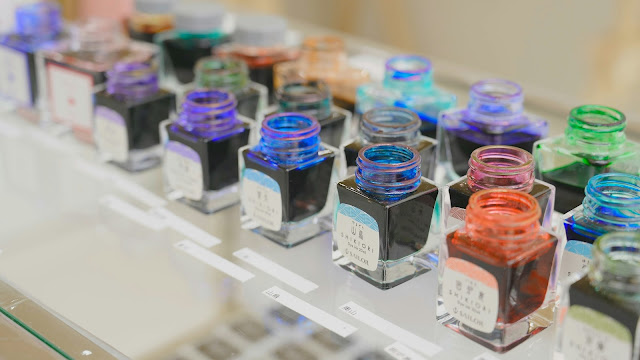Previously, we mentioned sheening and shimmering fountain pen inks. But what other types of "special" inks are there? Noodler makes the most of these special inks, so I'll mention a bunch of them here:
Anti-feather ink -- ink designed specifically NOT to feather, even on horrible paper such as newsprint, very opposite of fast-drying. Noodler's version is called "X-feather".
Anti-freeze ink -- Noodler's makes a series of inks that will not freeze until -20 F that they call "Polar" series. Yes, the pen will still write with temperature below zero! However, it also feathers very heavily.
 |
| Photo by Leo Okuyama on Unsplash |
Colorfast ink -- ink that will not wash out, and highly resistant to solvents. These go by various names depending on the vendor. Noodler calls theirs "bulletproof". These inks are hated by forgers and check-washers, who relies on solvents that can dissolve the ink... So they can write in a different amount. Colorfast ink makes that very difficult if not impossible.
Fast-drying ink -- made to help left-handed writers in a left-to-right writing world, these inks are dry to touch after maybe 10 seconds, even on super-slow paper such as Rhodia paper.
Highlighter ink -- technically they are made to refill highlighters, but some of them are fountain pen compatible, such as Noodler's Electric Color, Dragon Catfish, or Year of the Golden Pig.
Invisible Ink -- these are only visible under UV light. Some can be mixed with regular ink, or use alone to send secret messages.
Iron-gall ink -- some of the earliest ink are iron-gall inks. They use a mixture of iron salts and tannic acid to create a purple-black or brown-black ink. However, these inks are acidic and not suitable for fountain pens. "Modern" iron-gall inks that are marked "safe for fountain pen use" are available, and they make marks that are extremely difficult to erase, as the ink penetrates into the paper deeply. Iron gall ink should NOT be left in a pen that's only infrequently used, even "modern" iron-gall ink. Also see "pigment-based ink".
Lubricated ink -- some fountain pens are known to be "dry"... they don't feed much ink to the paper, making writing a bit difficult. A lubricated ink can help these pens perform properly. Keep in mind that a "wet" pen (one that already feeds a lot of ink) will likely leak badly with lubricated ink. Also, some older pens with piston type fillers or converters can benefit from lubricated ink.
Pigment-based ink -- similar to colorfast ink, and iron-gall ink, pigment ink is almost impossible to erase. However, pigment-based ink uses carbon-based pigments, and has a similar drying/clogging problem like iron-gall ink. Either use the pen frequently, or use a different ink. Wash the pen out thoroughly first before loading new ink.
No comments:
Post a Comment